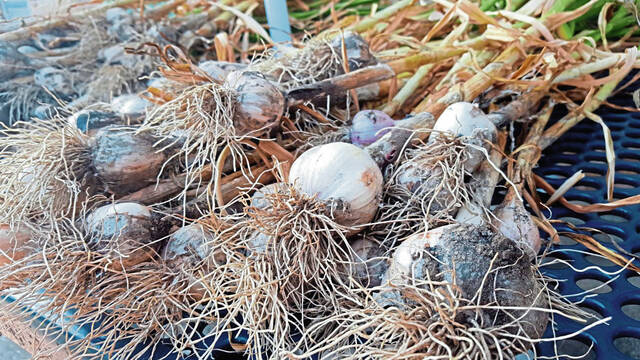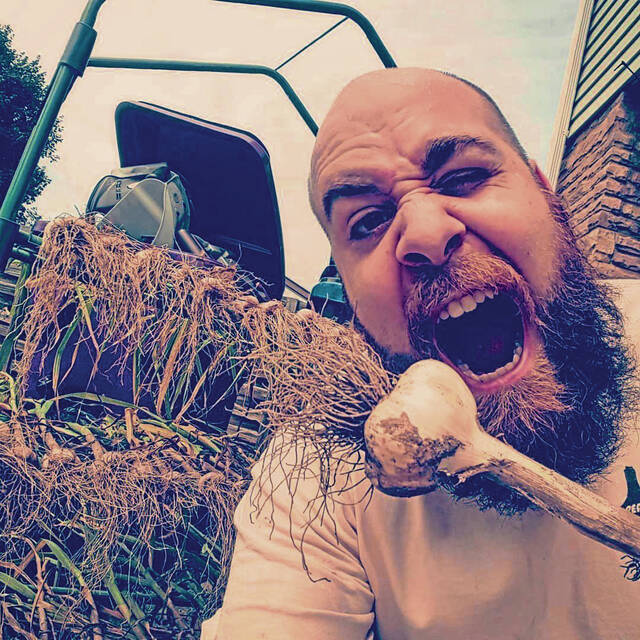Garlic growing in popularity among home gardeners
It’s small, it’s stinky and it can allegedly ward off vampires.
It’s garlic, and it’s also apparently gaining quite a bit of popularity with home gardeners.
According to a recent poll conducted by AllAboutGardening.com, home gardeners in a dozen U.S. states searched “how to grow garlic” more than questions about any other fall crop.
Residents in Alaska, Delaware, Hawaii, Kentucky, Nebraska, New Hampshire, New York, North Carolina, Rhode Island, South Dakota, Vermont and Wyoming all searched for it the most (in Pennsylvania, the top search was how to grow carrots).
As someone who grows garlic in the triple digits every season, I can tell you: there isn’t all that much to learn. Garlic is about as close as it gets to a set-it-and-forget-it crop.
And while you can certainly plant it in the springtime, most home gardeners plant their garlic in late October or early November, letting it overwinter in the ground and giving it a nice head-start in the spring.
If you’ve ever let garlic sit around the kitchen counter for too long, you’ve probably seen it start to sprout little green shoots from the top. That’s how aggressive this plant is — even without the presence of soil, it still wants to grow.
There are two primary types of garlic, soft-neck and hard-neck. Soft-neck garlic produces large bulbs with more cloves, and it also produces plants which can be braided and hung in the classic Italian-kitchen style to cure and dry. Hard-neck garlic produces a smaller bulb with fewer cloves — sometimes as few as four — but it can also bring a much more pungent taste profile to the table.
I grow about six or seven different types of garlic each year. When I harvest my garlic in the summer, I save the best-looking bulbs to replant. You just separate the cloves, space them about 6-8 inches apart, and pop them 2-3 inches under the soil with the pointy end facing up. I usually cover mine with a thick mat of straw.
By the time winter sets in, you’re likely to have little green nubs popping up all over the garlic bed. Like I said, they are aggressive; they want to grow. But they will overwinter under the straw, and start shooting up as soon as the weather begins to warm.
In mid- to late June, your garlic plants will share their first treat of the season: scapes.
Each plant will send a shoot straight up through the middle, which will begin to develop a small bulbil on top. This is called a garlic scape, and if left alone, it will form a bunch of little baby garlic seedlings. But you don’t want that.
These scapes will curl over on themselves, and when they do that, snip them off and use them in any number of different ways to take advantage of all the garlic flavor without the pungent bite you get from raw garlic. They are delicious chopped, sauteed in butter and tossed with pasta and olive oil. I prefer to make a cracker dip with cream cheese, scapes and bacon.
Snipping the scapes keeps the garlic plant from wasting energy trying to reproduce. It will now put all its growing energy into making the underground bulb bigger.
Once about half of the garlic plant’s leaves have started to brown (mid- to late July), it’s time to harvest. Dig ‘em up, find them a cool, dry place to cure for 2-3 weeks, trim the leaves off (or braid them if you’re growing all soft-necks) and you’ll have yourself a supply of garlic that will last a good six months in the right conditions.
To start your own garlic bed, there are a wide variety of farms where you can order “seed garlic,” which is usually just a paper bag full of garlic heads. You could try separating and planting cloves from the grocery store, but store-bought garlic is likely to be treated with chemicals in order deter pests as well as to discourage sprouting. Not to mention, ordering your garlic from a farm gives you the chance to browse the more than 20 different varieties of this delicious, diverse plant.
Here are a few other ideas for what to do with your garlic.
Twitter user MiroGal1 has a unique take on grilled cheese:
Roasted Garlic Caprese Grilled Cheese | https://t.co/IVfL29LUR6 https://t.co/yjHappTeHf via @hbharvest
— Mynameis...Miro #VoteBlue (@MiroGal1) September 6, 2022
Fettuccine with cured pork cheek, mushrooms and garlic? Why thank you, Twitter user @unpodiblu, I will have some, please:
Fettuccine with chanterelle mushrooms, guanciale, red onion and garlic... and sprinklings of parsley and parmesan ???? #foodhappiness #pasta #dinner#delicious #food @SteinBergRD https://t.co/ArPr5zYpkg pic.twitter.com/EyOExYDUIn
— Eat.. Drink.. Wine.. (@unpodiblu) September 6, 2022
And look, I’m not saying do it, but it’s at least interesting reading about the benefits of (gulp) putting garlic in your yogurt:
What are the benefits of eating garlic with yogurt? https://t.co/PhWwVeRM90
— GreenBHL (@GreenBhl) September 6, 2022
Patrick Varine is a TribLive reporter covering Delmont, Export and Murrysville. He is a Western Pennsylvania native and joined the Trib in 2010 after working as a reporter and editor with the former Dover Post Co. in Delaware. He can be reached at pvarine@triblive.com.
Remove the ads from your TribLIVE reading experience but still support the journalists who create the content with TribLIVE Ad-Free.




